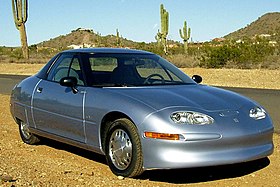| General Motors EV1 | |
|---|---|
 | |
| Overview | |
| Manufacturer | General Motors |
| Production | 1996–1999 |
| Model years |
|
| Assembly | United States: Lansing, Michigan (Lansing Craft Center) |
| Designer | Paul MacCready[1] |
| Body and chassis | |
| Class | Subcompact car |
| Body style | 2-door coupé |
| Layout | Transverse front-motor, front-wheel drive |
| Powertrain | |
| Electric motor | |
| Transmission | Single-speed reduction integrated with motor and differential |
| Battery |
|
| Electric range |
|
| Plug-in charging | 6.6 kW Magne Charge inductive converter |
| Dimensions | |
| Wheelbase | 98.9 in (2,510 mm)[2] |
| Length | 169.7 in (4,310 mm)[2] |
| Width | 69.5 in (1,770 mm)[2] |
| Height | 50.5 in (1,280 mm)[2] |
| Curb weight |
|
The General Motors EV1 is a battery electric car produced by the American automaker General Motors from 1996 until its demise in 1999.
A subcompact car, the EV1 marked the introduction of mass produced and purpose-built battery electric vehicles.[3][4] The conception of the EV1 dates back to 1990 when GM introduced the battery electric "Impact" prototype[5], upon which the design of the production EV1 was largely inspired. The California Air Resources Board enacted a mandate in 1990, stating that the seven leading automakers marketing vehicles in the United States must produce and sell zero-emissions vehicles to maintain access to the California market.
Mass production commenced in 1996. In its initial stages of production, most of them were leased to consumers in California, Arizona, and Georgia. Within a year of the EV1's release, leasing programs were also launched in various other American states. In 1998 GM unveiled a series of adaptations for the EV1, encompassing a series hybrid, a parallel hybrid, a compressed natural gas variant, as well as a four-door model, all of which served as prototypes for possible potential future models. Despite favorable customer reception, GM believed that electric cars occupied an unprofitable niche of the automobile market. The company ultimately crushed most of the cars, and in 2001 GM terminated the EV1 program, disregarding protests from customers.
Since its demise, the EV1's cancellation has remained a subject of dispute and controversy. Electric car enthusiasts, environmental interest groups, and former EV1 lessees have accused the company of self-sabotaging its electric car program to avoid potential losses in spare parts sales,[note 1] while also blaming the oil industry for conspiring to keep electric cars off the road.
- ^ "GM EV1 and the Los Angeles City Council (53 items) | MacCready Papers". Caltech Archives. 1996-01-22.
- ^ a b c d "Automotive Engineering". Automotive Engineering. Vol. 104. United States: Society of Automotive Engineers. 1996. p. 69.
- ^ Adler, Alan L. (1996-09-29). "Electrifying Answers". Chicago Tribune. Archived from the original on 2013-10-29. Retrieved 2024-03-27.
- ^ "History of the electric car: from the first EV to the present day". Auto Express. 2020-05-04. Archived from the original on 2023-11-30. Retrieved 2024-03-30.
- ^ "1990 Impact Experimental | GM Heritage Collection". General Motors. Archived from the original on 2024-08-28. Retrieved 2024-11-19.
Cite error: There are <ref group=note> tags on this page, but the references will not show without a {{reflist|group=note}} template (see the help page).